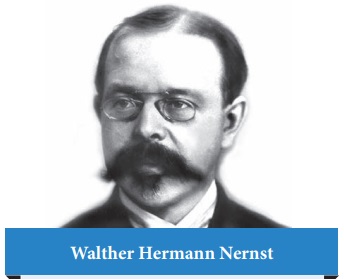Electro Chemistry | Chemistry - Electro Chemistry | 12th Chemistry : UNIT 9 : Electro Chemistry
Chapter: 12th Chemistry : UNIT 9 : Electro Chemistry
Electro Chemistry
ELECTRO CHEMISTRY

Walther Hermann Nernst
Walther Hermann Nernst, was a German chemist known for his work in thermodynamics, physical
chemistry, electrochemistry, and solid state physics. His formulation of the
Nernst heat theorem helped to pave the way for the third law of thermodynamics,
for which he won the 1920 Nobel Prize in Chemistry. He is also known for
developing the Nernst equation in 1887. He also derived the Nernst equation for
the electrical potential generated by unequal concentrations of an ion
separated by a membrane that is permeable to the ion. His equation is widely
used in cell physiology and neurobiology.

Learning Objectives
After learning this unit, the students will be able to
• Recognise the conductivity of electrolylic
solution
• Define the terms resistivity, conductivity
equivalent and molar conductivity
• Explain the variation of conductivity with
concentration
• Apply Kohlrausch law to calculate the
conductivity of weak electrolyte at infinite dilution.
• Describe an electrochemical cell
• Differentiate between an electrochemical and electolylic cell
• Represent a galvanic cell using IUPAC cell notation
• Derive Nernst equation and apply it to calculate Ecell.
• Define Faraday’s Law of electrolysis
• Describe the construction of batteries
• Explain corrosion as an electrochemical process.
INTRODUCTION
We have come across many materials in our life, and they can be broadly
classified into conductors, semiconductors and insulators based on their
electrical conductivity. You might have noticed that conducting materials such
as copper, aluminium etc., are used to transport electrical energy from one
place to another place, and the insulating materials such as PVC, Bakelite etc.,
in switches, circuit boards etc., Do you know how the electrical energy is
generated? We know from first Law of thermodynamics that energy can neither be
created nor be destroyed, but one form of energy can be converted into another
form. It is not possible to create electrical energy but we can generate
electrical energy in many ways i.e., by converting solar energy, wind energy,
tidal energy etc.... one such a way is converting chemical energy into
electrical energy as in the case of batteries. We cannot imagine a modern
technological world without batteries. Hence it is important to know the
principles behind this type of energy conversion. The branch of chemistry that
deals with the study of electrical energy transport and the inter conversion of
electrical and chemical energy is called electrochemistry. Electrochemical
reactions are redox reactions and they involve the transfer of electron from
one substance to another.
In this unit, we will learn about the electrical conduction,
construction of batteries and the thermodynamic principles involved in electro
chemical reactions.
Related Topics